This step by step diy project is about 10×32 lean to patio cover plans. This lean to has a 2:12 pitch and it can be both used to extent the living space or simply for storage. Being a simple wooden structure, so you should be able to get the job done as a DIY project. Nevertheless, check your local codes before staring the project, and make adjustments, if necessary. Take a look over the rest of my woodworking plans, if you want to get more building inspiration.
Enhance your outdoor space with the practical benefits of a 10×32 patio cover. This sizable addition provides a comfortable seating area and reliable protection from the elements, making it an ideal retreat for various activities. Whether you’re seeking shade on a sunny day or a cozy shelter during light rain, a 10×32 patio cover transforms your backyard into a versatile and enjoyable space throughout the seasons.
When buying the lumber, you should select the planks with great care, making sure they are straight and without any visible flaws (cracks, knots, twists, decay). Investing in cedar or other weather resistant lumber is a good idea, as it will pay off on the long run. Use a spirit level to plumb and align the components, before inserting the galvanized screws, otherwise the project won’t have a symmetrical look. If you have all the materials and tools required for the project, you could get the job done in about a day.
Projects made from these plans
10×32 Lean to Patio Cover – PDF Download
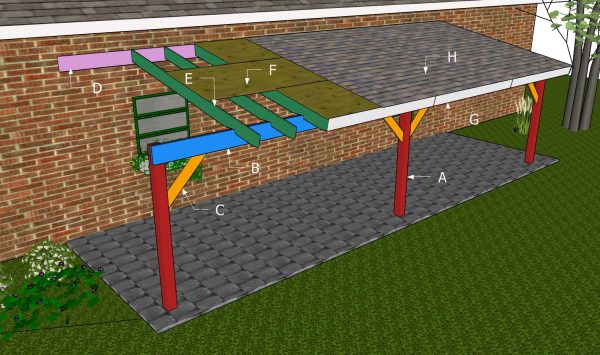
Building a 10×32 lean to patio cover
Cut & Shopping List
Tools
![]() Hammer, Tape measure, Framing square, Level
Hammer, Tape measure, Framing square, Level
![]() Miter saw, Drill machinery, Screwdriver, Sander
Miter saw, Drill machinery, Screwdriver, Sander
![]() Concrete mixer, Post hole digger
Concrete mixer, Post hole digger
Time
Related
Building an attached carport – 10×32 DIY Plans
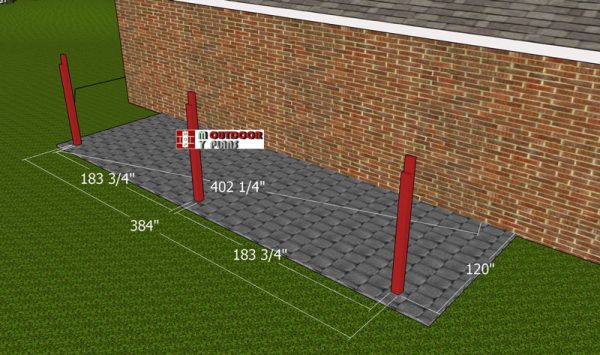
Laying-out-the-posts
The first step of the project is to set the 6×6 posts for the wooden attached patio cover. Use batter boards and string to layout the posts for the 10×32 structure. After laying out the posts, measure the diagonals and make adjustments until they are perfectly equal.
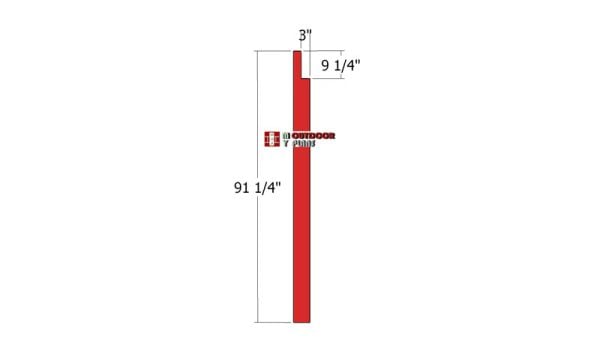
Posts
As you can notice in the diagram, you need to make notches to the top of the posts. Set the blade for a circular saw at 3″ and then make parallel cuts inside the marked areas. Use a hammer and a chisel to clean the recess and smooth the surface.

Anchoring the posts of the anchor
You can set the posts in concrete or you can pour 3′ deep footings and use posts anchors. You can also set the posts to concrete footings with anchors. That is why, these plans are designed having that assumption in mind (concrete anchors).
Dig the holes and set the 14″ tube forms. Fill the tubes with concrete and set the post anchors. Make sure you let the concrete to dry out for a few day, before installing the posts into place. Use temporarily braces to secure the posts until you attach the plates.
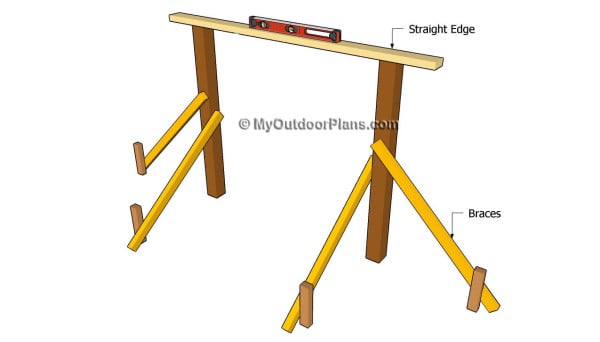
Installing the posts
Use a laser level / water level to make sure the top of the posts are at the same level.
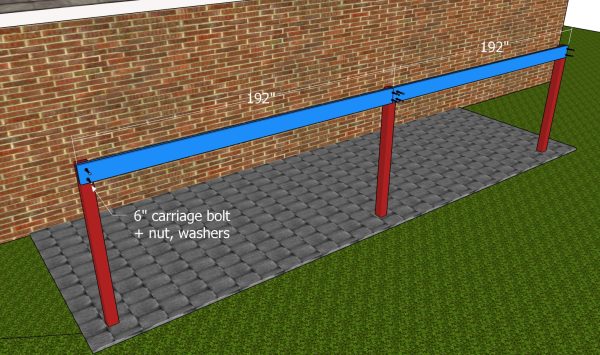
Fitting the support beams
We need 2×10 lumber for the support beams. Attach the support beams to the top of the posts. Drill pilot hole and insert 6″ carriage bolts to lock the beams into place. Use 2 bolts for each joint. Make sure you add washers and a nut to tighten the bolts.
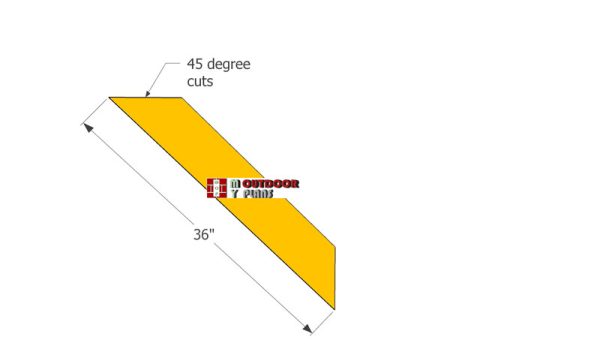
Braces
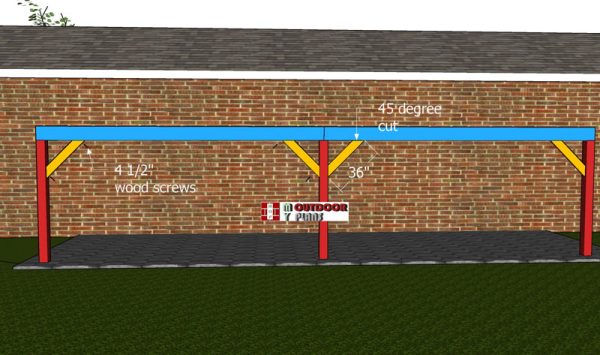
Braces-for-large-patio-cover
Use 6×6 lumber for the braces. Make 45 degree cuts at both ends of the braces and then secure them into place with 4 1/2″ screws (at least 2 screws for joint).
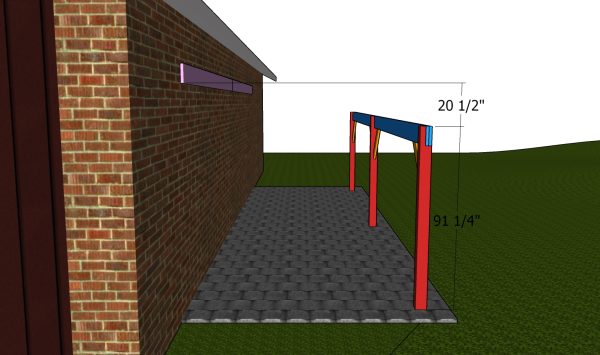
Aligning the ledger boards
Next, we need to attach the 2×10 ledger to the house. Make sure you set the 2×10 ledger directly into the framing structure with 4 1/2″ lag screws with washers (or longer, depending to the house structure). Use a spirit level to check if the ledger is horizontal.
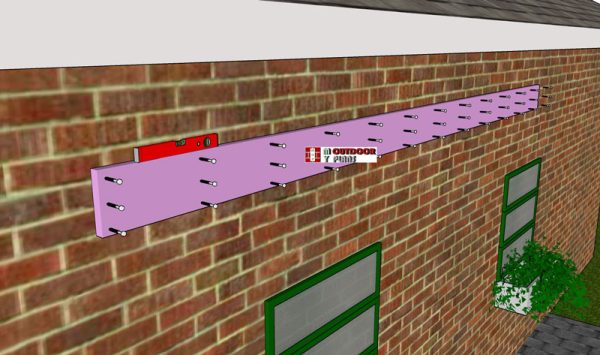
Ledger-board
Drill pilot holes and insert the screws to lock it into place tightly (see your local codes for more info on how to secure the ledger). Insert 3 screws into each stud.
Building the lean to roof
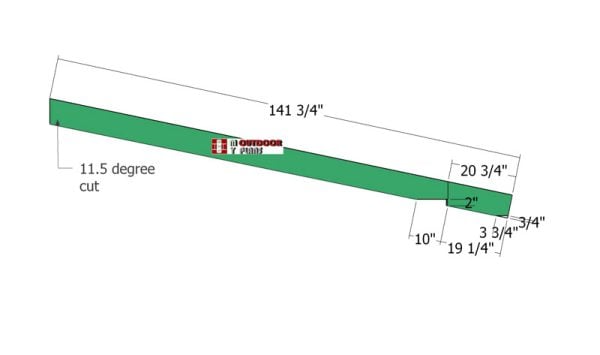
Rafters—detail
Use 2×8 lumber for the rafters. Make a 11.5 degree cut to one end of the rafters. Mark the cut lines on the beams and then get the job done with a circular saw. Smooth the edges with sandpaper.
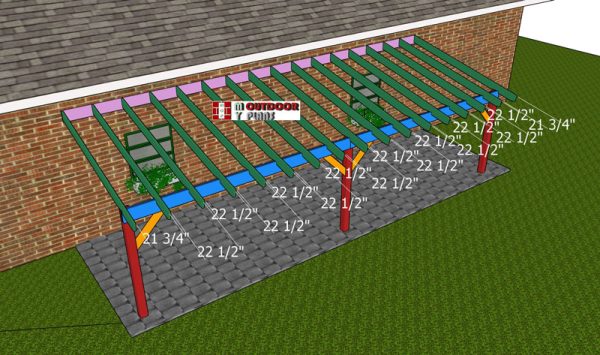
Fitting-the-rafters
Fit the rafters to the attached patio cover, every 24″ on center.
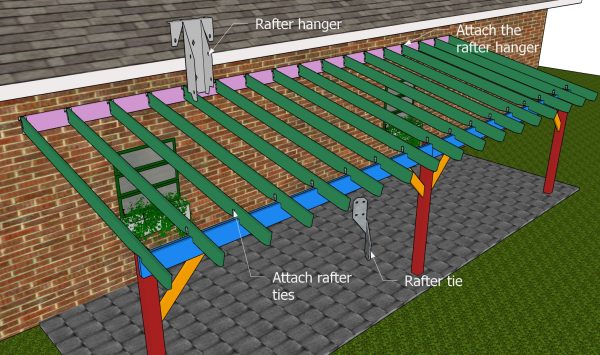
Metal connectors
Fit the rafters to the ledger beams using rafter hangers and 1 1/2″ structural screws. Use rafter ties and 1 1/2″ structural screws to lock the rafters to the support beams.
To attach rafters with rafter hangers, first, position the hangers along the support beams at the desired spacing, ensuring they are level and aligned.
Next, place the rafters into the hangers, making sure they fit snugly, and then secure them with appropriate nails or screws to create a sturdy and reliable patio cover structure.
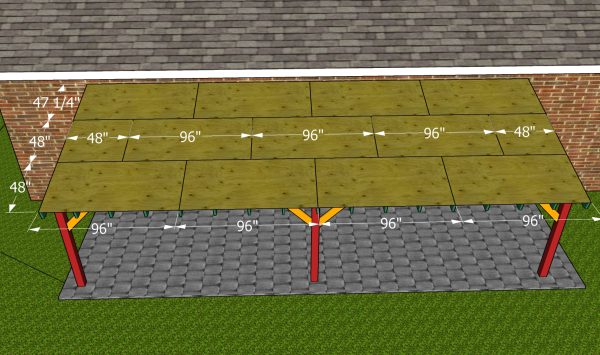
Roof sheets
Fit the 1/2″ plywood sheets to the top of the patio cover. Start with the lower left area of the roof and go up to the top. Use 1 5/8″ screws to secure the sheets into place, every 8″ along the framing. Leave no gaps between the sheets and align the edges flush.
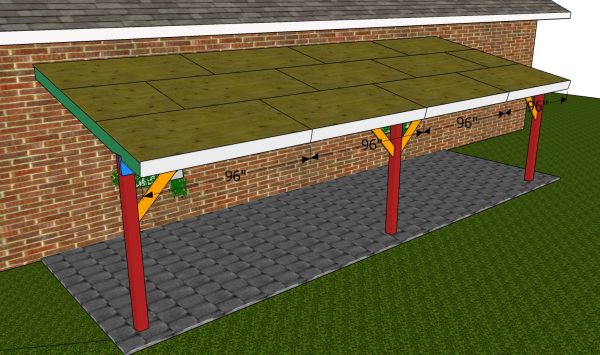
Front roof trims

Side-roof-trims
Cut and fit the trims for the lean to. Fit the 1×8 trims to the front of the patio cover. Use 2″ nails to secure the trims to the ends of the rafters.
Attach the trims to the sides of the patio cover. Make the 11.5 degree cut to one end of the trims and then secure them to the rafters with 2″ nails.

Installing-the-roof-flashing
In addition, install a flashing at the intersection of the roof to the wall. The flashing will waterproof the joint and prevent water leaks. Make sure you ask directions from the roof manufacturer, so you use the best solution to seal the wall to roof joint (see if it’s installed under or over the roof sheets).
Start by measuring the area where the flashing will be installed and cut the metal flashing to the appropriate size using tin snips or a metal cutting tool. Clean the surface where the flashing will be attached and ensure it is dry and free of debris. Apply a layer of construction adhesive to the back of the flashing and press it firmly against the wall, aligning it with the desired position. Secure the flashing in place with galvanized nails or screws, ensuring they are evenly spaced and driven flush with the surface.
Finally, inspect the installation for any gaps or loose sections, making any necessary adjustments. With careful attention to detail and adherence to safety precautions, you’ll successfully install metal wall flashing to provide protection and enhance the durability of your walls.
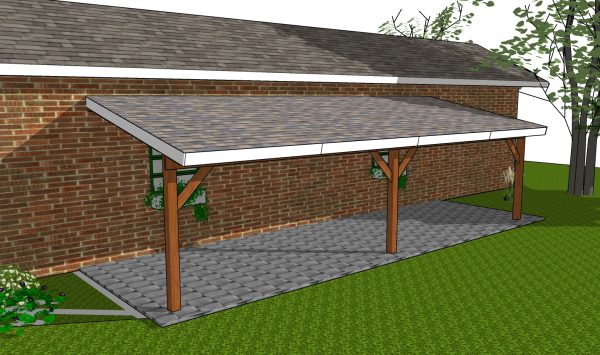
10×32 lean to patio cover
Last but not last, you need to take care of the finishing touches. Fill the holes with wood putty and let it dry for several hours. Smooth the surface with 120-220 grit sandpaper and apply a few coats of stain to enhance the natural look of lumber and to protect the components from the elements.

10×32 lean to patio cover – side view
The clean, white finish of the 10×16 lean-to patio cover can provide a bright and inviting ambiance in your outdoor space. Whether you’re looking for a serene oasis or a functional outdoor extension of your home, the white cover can complement various design styles and create a welcoming atmosphere.

10×32 lean to patio cover – dimensions
Wrap your outdoor space in the warmth of a 10×32 patio cover, creating a cozy haven that invites you to relax and enjoy the changing seasons with comfort and ease.
Beyond the core structure, you can also explore a myriad of personalized enhancements to tailor your 10×32 patio cover project to your unique taste and lifestyle. Consider incorporating ambient lighting for cozy evenings, investing in comfortable seating options that beckon relaxation, and adding decorative elements that resonate with your outdoor aesthetic, ensuring that your transformed space is not just functional but also a true reflection of your personal style.
If you want to get the Premium Plans, see the GET PDF PLANS button bellow.
This woodworking project was about 10×32 attached patio cover plans. If you want to see more outdoor plans, check out the rest of our step by step projects and follow the instructions to obtain a professional result.


2 comments
Do you got a 10 x 45 patio cover plan like this one?
I have a 10×40 in the shop (referring to the base, roof is larger)